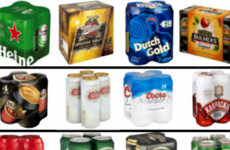
CALIFORNIA MILK PRODUCER have modified an eyebrow-raising advertising campaign that promoted their product to men as a way to lessen the effects of premenstrual syndrome in their wives or girlfriends.
While the benefits of calcium to women are widely accepted, the over-the-top publicity campaign featuring harried-looking men, color-coded PMS meters and “video apology enhancers” may be doing the industry in the nation’s top milk-producing state more harm than good.
Marketing experts say the California Milk Processor Board, previously known for its popular “Got Milk?” promotions, resorted to shock advertising that may have earned it negative attention without benefiting the product it was trying to sell.
“It might have been too shocking, and too much negative attention. And really, it was negative attention that was not related to milk,” said Laura Ries, president of the Atlanta marketing strategy firm Ries & Ries.
The board, which is overseen by the state Department of Food and Agriculture but is privately funded, decided this week to modify its two-week-old campaign and redirected users from its website, www.everythingidoiswrong.org, to another that will encourage discussion of the issue.
The original campaign, featuring an Internet splash page, billboards and announcements on National Public Radio, had been scheduled to run through the end of August.
Benefits of milk
Steve James, the milk board’s executive director, said the advertising had accomplished the board’s goal of spreading awareness about the benefits milk can have on women who suffer the effects of PMS — and on their male partners.
“We’ve started out as a California campaign, and it has become a subject of discussion around the country,” he said. “We set out to spark the issue about something that affects both men and women, and we certainly did get a discussion going.”
There is no doubt of that.
The campaign’s website said as many as 1,500 media outlets worldwide reported on the ads, which drew attention on national television talk shows and resonated widely online. Negative comments poured in from women and female-oriented media, and a Facebook site was dedicated to reaction — most of it negative.
Many comments suggested women were offended that the campaign portrayed men as the victims of premenstrual syndrome. Billboards in Los Angeles and San Francisco, for example, showed young men holding cartons of milk accompanied by tag lines such as “I’m sorry I listened to what you said and NOT what you meant,” or “I apologize for not reading between the RIGHT lines.”
Jessica Coen, editor-in-chief of the website Jezebel, which caters to women, said it was reassuring to see the campaign altered. But she was skeptical of the milk board’s new approach of trying to further the discussion.
“You can still talk about the PMS issue, you can still use that discussion, but not the way they did it,” she said.
Outcry
Jeffrey Goodby, co-chairman at the advertising firm behind the campaign, Goodby, Silverstein & Partners, said his company had helped the milk board advertise the various benefits of milk before — such as shinier hair and stronger nails, and as an effective sleep aid. But none had received anything like the reaction to the PMS campaign.
“We’ve never had an enormous outcry about this benefit before,” he said. “The idea when we undertook it was to inform the public about it. We thought it was a public service.”
He added that a majority of those involved with creating the campaign were women.
There is at least some basis for the milk board promoting further discussion of the issue — and continuing its campaign.
The advertising was based on studies published in scientific journals in 1999 and 2005 that found a link between calcium consumption and fewer PMS symptoms.
Researchers in the 2005 study followed and recorded the dietary intake of more than 3,000 women for 10 years. None had been diagnosed with clinical PMS when the trial started in 1991, but some got that diagnosis later in the trial.
“We found that the women with the highest intakes of calcium and the highest intakes of vitamin D had the lowest risk of developing PMS during the course of follow-up,” said Elizabeth Bertone-Johnson, an associate professor of epidemiology at the University of Massachusetts in Amherst and one of the researchers behind the study.
She said a substantial amount of the calcium and vitamin D the participants were receiving came from milk and not from dietary supplements. But she said it also is important to note that those nutrients were shown to improve symptoms only in women who had been diagnosed with severe PMS, not in women who were experiencing minor symptoms.
“We don’t know if calcium will work with respect to any symptoms or symptoms of mild severity,” Bertone-Johnson said.
The study was published in the Archives of Internal Medicine and received some funding from GlaxoSmithKline, which manufactures calcium supplements. That industry funding was enough to make other researchers skeptical.
Marion Nestle, a professor at New York University’s Department of Nutrition, Food Studies and Public Health and author of the blog “Food Politics,” said dairy products are not an essential nutrient.
“The dairy industry lobbies ferociously to make sure dairy stays prominently in dietary guidelines,” Nestle said in an email. “I never pay attention to any study sponsored by the dairy industry or drug companies.”
- AP









COMMENTS (3)